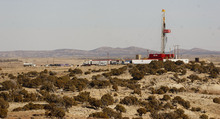This is an archived article that was published on sltrib.com in 2014, and information in the article may be outdated. It is provided only for personal research purposes and may not be reprinted.
Controlling "spuds," "blowdowns," and "fugitive leaks" at oil and gas developments could serve beneficial in reducing the uniquely high winter ozone levels in the Uinta Basin.
Implementing those changes, however, may be a challenge because of landownership issues.
The Utah Division of Air Quality (DAQ) on Tuesday released the latest installment of a multimillion-dollar "Winter Ozone Study," confirming cold weather inversions and oil and gas development in northeastern Utah to be the source of dangerous ozone levels in the Uinta Basin — and pointing to seasonal controls as a way to mitigate the problem.
Ozone, a pollutant that causes a number of respiratory ailments, is most associated with large cities and typically happens in the summer months, but monitoring in the winter of 2009-2010 showed elevated levels in the Uinta Basin.
Since then, state regulators, scientists, federal agencies and energy developers have studied the area to understand why, and what can be done about it.
The latest, 2013 report suggests controlling when new drilling begins (spudding), when equipment, facilities and wells are vented of accumulated gas (blowdown) and taking care of unseen leaks might help.
The majority of Utah's oil and gas production happens in the Uinta Basin. The industry is important to the economy of the Basin and the state and is a prime contributor to ozone, the report says.
"There are a lot of volatile organic compounds (VOC) as you might expect in oil and gas fields,"DAQ Deputy Director Brock LeBaron said. "They tend to build up with the trapping effect of inversion, allowing the chemistry normally associated with summer to show up in the winter."
Recently implemented federal standards will put a dent in VOC production in coming years, LeBaron said. "We are working with producers to come up with new rules on existing equipment on what can be done to improve legacy equipment. New equipment is much cleaner."
Imposing additional seasonal controls would require further study, he said. "We don't want to be controlling or restricting people when it isn't necessary. The reports give us a tool to create useful models."
At times, the wintertime ozone pollution in the basin has been as bad as the worst summertime ozone in the nation — identified by the Environmental Protection Agency as San Bernardino County, Calif. Uintah County's ozone has some years topped the worst high-ozone days in Salt Lake City and even Houston and Los Angeles.
A combination of factors contributes to the vexinglevels, including the presence of snow on the ground. Reflection of light from the snow cooks precursor chemicals that combine to form ozone.
Without snow, warming of the land causes too much convective mixing for the cold pool to form, according to the report.
The winter of 2012 provided little snow and not one case of ozone levels breaking the National Ambient Air Quality Standard of 75 parts per billion (ppb) for an eight-hour average.
What a difference a year makes.
Between December 2012 and March 2013, ozone readings at one station near Vernal reached 142 ppb, 89 percent over the EPA standard, according to the report.
Ozone levels during daytime monitoring in the 2011-12 winter did not exceed 63 ppb.
In the winter of 2013, ozone levels exceeded the EPA standard at 17 of the 20 monitoring sites.
The report states that the coal-fired Bonanza power plant plume does not appear to contribute any significant amount of contaminants to the polluted layer during ozone episodes. The plume from the 600-foot stack penetrates through the temperature inversion layer.
"In general, winter ozone is a tricky animal. For decades scientists and regulators have been focused on summertime ozone," said Kathleen Sgamma, vice president of government and public affairs for Western Energy Alliance, a trade group representing oil and natural gas companies. "Without the correct weather conditions, there wouldn't be high ozone at all. Once the phenomena was recognized, regulators, industry and the local community got together to try and understand what is going on."
Creating regulations and implementing them will likely prove difficult. The Uintah and Ouray Indian Reservation makes up a large part of the Uinta Basin and a significant number of oil and gas developments are located on those lands, which are not regulated by the state, but by the EPA.
"We are trying to work together and coordinate our efforts," LeBaron said. "It's important to try and come up with consistent regulations across the Basin. The producers want consistency."
Environmental groups say the EPA's ozone standards are too liberal, and they doubt ozone can be effectively managed with seasonal controls.
"Pollution from industry is a year-round issue and health consequences to the local population, if not to the entire region, are year-round," said Brian Moench, president of Utah Physicians for Healthy Environment. "Many of the compounds that are precursors of ozone— VOCs like formaldehyde and toluene — are more toxic than ozone, yet discussion of control strategies seems focused primarily on how they will affect ozone formation."
Tribune reporter Kirsten Stewart contributed to this report.
Twitter: @BrettPrettyman







